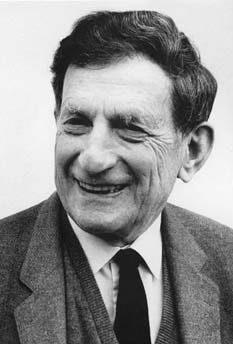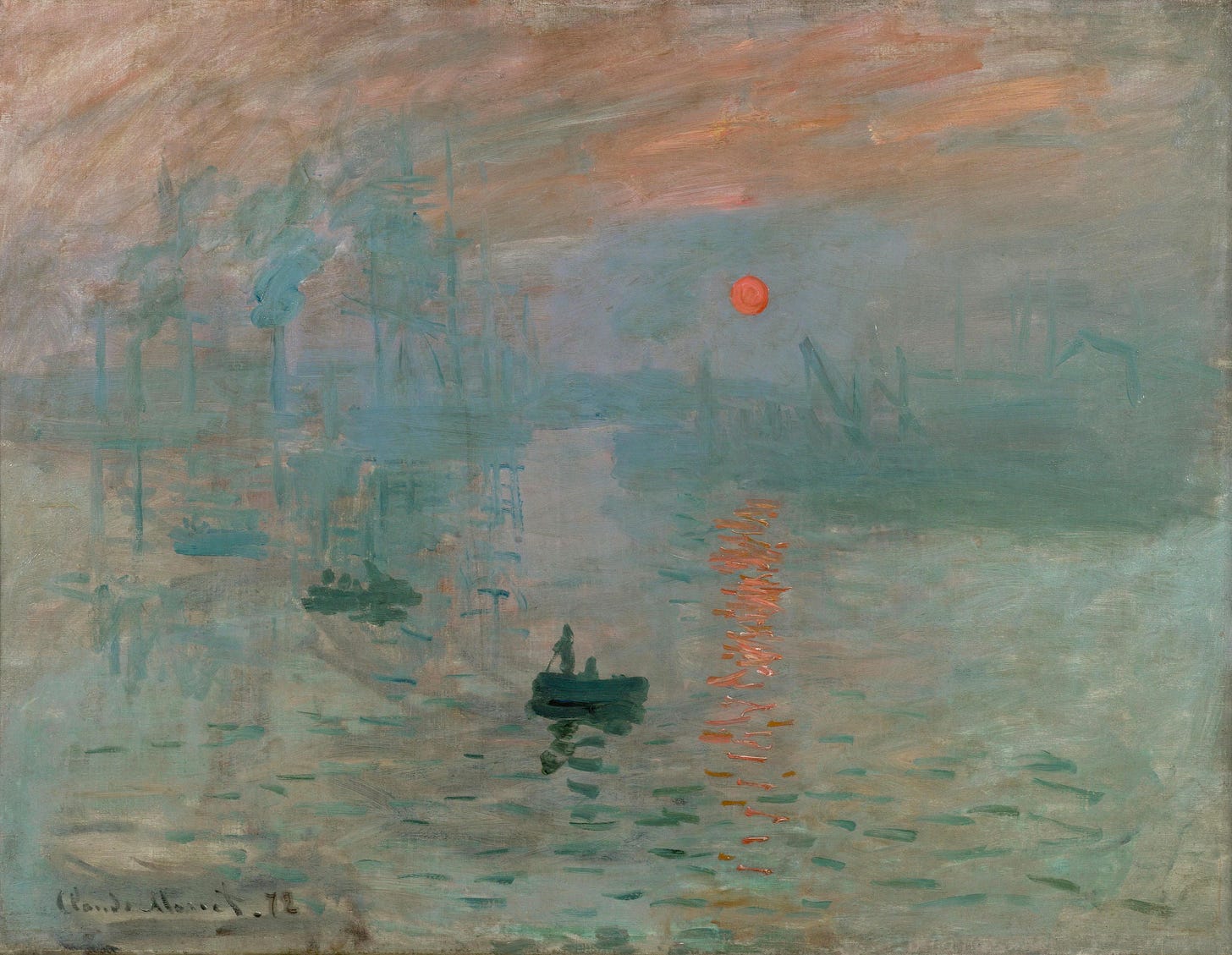"First they ignore you, then they laugh at you, then they fight you, then you win.”
~ Incorrectly attributed to Mahatma Gandhi
1874. Claude Monet was frustrated.
French art had become so stultified, so academic — dominated by carefully detailed, refined classical forms painstakingly crafted to appease the conservative tastes of middle-class Salon attendees.
The gatekeepers ruled the roost. Quality was determined not by passion, innovation, or excitement but by the jury of the Paris Salon, a comfy clique who unilaterally determined which works were worthy of display.
Monet and a group of his contemporaries had grown weary of the arbitrary proclamations of the jury; and the rigid ‘official’ art it endorsed. Their anger was fueled by a healthy dose of personal grievance — many of them were still smarting from the sting of rejection by the Salon.
Time to f*ck the system. They organized their own exhibition, bypassing the cumbersome jury system to present their work directly to their audience.
On April 15, 1874, two weeks before that year’s Salon opened, the newly christened Société anonyme des artistes, peintres, sculptures, graveurs, etc, launched their opening salvo — an exhibition at 35 Boulevard des Capucines, just a few minutes north of the Louvre.
165 works were on display, including paintings by Renoir, Pissarro, and Degas. Monet, too, staked his claim to the counterrevolution, exhibiting his atmospheric, languid, Impression, Sunrise (pictured above).
Though stylistically diverse, the collected works constituted a dramatic departure from the refined precision of classical art. They presented, in other words, one big, colorful middle finger to the establishment.
The art critic Louis Leroy was one of the 3,500 people who visited the month-long exhibition (a far cry from the 400,000 or so who visited that year’s Salon).
His verdict? Scathing.
He published a satirical article in the newspaper Le Charivari which, though doubling as a criticism of Paris’ snooty establishment, was unsparing in savaging the exhibited works. Monet’s painting came under particular attack; breezily dismissed as a half-finished scribbling:
“Wallpaper in its embryonic state is more finished than that seascape.”
Leroy’s mockery extended to the review’s very title, which deprecated the movement with a dismissive moniker:
"The Exhibition of the Impressionists."

1952. The 20th century had birthed numerous earth-shattering scientific breakthroughs, but none were bigger — nor more controversial — than those of Albert Einstein and Niels Bohr, whose respective theories of relativity and quantum mechanics questioned the very nature of reality itself.
A problem. These theories did not make for comfortable bedfellows. The cosmic sweep of relativity simply could not connect to the subatomic bizarreness of the quantum world.
Enter David Bohm.
Bohm wasn’t content with patching together the existing frameworks. He sought something more radical: a new paradigm entirely, one that could unite the cosmic and quantum realms under a single, coherent vision.
His theory of “hidden variables” was nothing short of revolutionary, questioning the premises of Bohr’s dominant Copenhagen interpretation.
Bohm made his move. He submitted his paper, A Suggested Interpretation of Quantum Mechanics in Terms of ‘Hidden Variables,’ for publication in the Physical Review journal, anticipating that he had just fired the opening salvo of what could become a scientific revolution.
But Bohm had made powerful enemies. Before the paper’s publication, he had been forced into exile after being caught up in McCarthy’s Red Scare, a victim of a youthful dalliance with the Communist party (all he’d wanted was a safe space to discuss Hegel!). And his theory, which challenged the very foundations of scientific consensus, was too hot to handle.
One man’s support may have made the difference. Over the ‘30s and ‘40s, Bohm had become close friends and a loyal student of the brilliant, mercurial J. Robert Oppenheimer.
While Bohm lingered in exile among the sweltering lecture halls of Sao Paulo University, Oppenheimer called a conference at Princeton to discuss the paper. There, a group of leading physicists began to apply the scalpel, dissecting Bohm’s theory to find the flaws.
But they couldn’t. Bohm’s thesis proved stubbornly, defiantly persistent.
Science had failed them. To be rid of Bohm, they would have to rely on a blunter instrument. It was Bohm’s mentor, Oppenheimer, who stood up and delivered the final betrayal:
“If we cannot disprove Bohm, then we must agree to ignore him.”

1981. A young Australian physician named Barry Marshall was about to stumble onto something extraordinary.
He and his colleague, pathologist Dr. Robin Warren, had identified a distinctive, corkscrew-shaped bacteria in the stomachs of ulcer patients (later named Helicobacter pylori.)
This seemingly innocuous observation threatened to upend scientific consensus. Everyone knew that ulcers were caused by stress, spicy food, and excess stomach acid. Obviously, no bacteria could survive in the acid bath of the human stomach.
Marshall and Warren had other ideas. They persisted. They devoured the research, connecting disparate parts of previously isolated literature. They tested, tested, and tested again.
The more work they did, the more they began to believe that their hypothesis had legs. Maybe bacteria really was to blame.
But, though Marshall and Warren received periodic support, the establishment remained cynical, even hostile. Marshall was labeled a “brash young man,” a “zealot.” In 1983 the Gastroenterological Society of Australia rejected Marshall and Warren’s abstract, claiming it was in the bottom 10 percent of only 67 applications.
“Everyone was against me,” claimed Marshall. “But I knew I was right, because I actually had done a couple of years' work at that point. I had a few backers. And when I was criticized by gastroenterologists, I knew that they were mostly making their living doing endoscopies on ulcer patients. So I'm going to show you guys.”
Furious, Marshall decided to take a page from medical history. He’d heard stories about John Hunter, who infected himself with syphilis. Now, Marshall would have to take things into his own hands.
Or, more accurately, his own mouth.
In 1984, he prepared a cloudy broth containing a cultured version of bacteria taken from a patient with gastritis (“we calculated out later that it was a thousand million bacteria.”)
“Well, here it goes, down the hatch."
The Exhibition of the Impressionists was a failure.
The Société, buried in debt, was liquidated within months.
But the Impressionists had the last laugh.
By the mid-1880s, the mighty Salon’s influence was crumbling, its stranglehold on Parisian art slipping away.
Meanwhile, after seven more exhibitions, Monet and his band of revolutionaries had earned what the establishment had denied them: significant public and critical acclaim.
The coup-de-grace? Their movement had adopted a new name, one whose origins lay in the breezy dismissal of a Parisian critic:
Impressionism.
What had started as a sneer was now a badge of honor.
After Oppenheimer’s edict, the grand old men of physics sharpened their knives.
Bohm had written “a cheque that cannot be cashed,” scoffed Wolfgang Pauli. He’d indulged in “a physical fairy tale for children,” sneered Albert Einstein.
Bohm himself was forced into giving up his U.S. passport in 1954. But hidden variables theory was not yet dead, and neither was Bohm.
In 1964, physicist John Bell, inspired by Bohm's work, began investigating the fundamental questions of quantum mechanics. "In 1952, I saw the impossible done," Bell would later write. "It was in papers by David Bohm."
Through Bell's theoretical work and Bohm’s own collaboration with Basil Hiley, his theory gained new life.
Today, Bohm’s thesis remains an influential interpretation of quantum mechanics. Says Roger Penrose: “If you’re looking at ways of interpreting quantum mechanics, the Bohm-Hiley approach has the most satisfactory ontology.”
In 2020, a documentary on Bohm’s life and ideas was released.
Oppenheimer’s edict had failed. Bohm’s ideas were ignored no more.
Marshall was sick.
After drinking the bacteria-laden broth, he’d developed gastritis, the precursor to ulcers. A biopsy confirmed what the medical establishment had refused to accept: bacteria had invaded his stomach lining.
After some stern words from his wife, he began taking antibiotics.
The result? He was cured.
Despite publishing his findings in 1985, it would take another decade before the medical establishment accepted the role of H.pylori in stomach ulcers.
In 2005, Marshall and Warren were awarded the Nobel Prize in Physiology or Medicine for their discovery.
The “zealot” was right. No one was ridiculing him now.
"Truth never comes into the world but like a bastard, to the ignominy of him that brought her birth."
— John Milton
"When a true genius appears, you can know him by this sign: that all the dunces are in a confederacy against him."
— Jonathan Swift
Sources & Further Reading
AN IDIOT’S GUIDE TO THE IMPRESSIONIST PAINTERS; by Mary Anne (Maryne Anne’s France)
150 years ago today, at precisely 8pm, the world of art changed forever; by The Cultural Tutor
Before the Impressionists, These Artists Dominated the Parisian Art World; Demie Kim (Artsy)
150TH ANNIVERSARY OF IMPRESSIONISM (The Clark)
First Impressionist Exhibition (Wikipedia)
8 ‘IMPRESSIONIST’ EXPOSITIONS (Impressionism)
Bohmian Mechanics and NPQG III; by J Mark Morris (Neoclassical.ai)
David Bohm (Wikipedia)
Infinite Potential: Film director Paul Howard talks about his new film on the life and ideas of the physicist and philosopher David Bohm (Beshara Magazine)
David Bohm silenced by his colleagues (Infinite Potential)
Bohm, David Joseph (Encyclopedia.com)
On the Impossible Pilot Wave; by J. S. Bell (Foundations of Physics)
Interview: Barry Marshall, Nobel Prize in Medicine (Academy of Achievement)
Barry Marshall, from Quack to Nobel Prize; by Dr. Gabe Mirkin
The Doctor who Infected Himself to Solve a Medical Mystery (Guts UK!)
Barry Marshall (Wikipedia)
How Easter Helped Bring Down a Medical Myth About Ulcers; by Megan Gannon (Live Science)


loved this. 🙏🏾